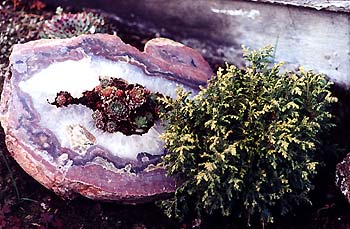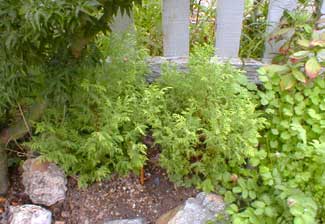 The Eenciest of Teency Trees:
The Eenciest of Teency Trees:
Chamaecyparis pisifera 'Cream Ball'
"Here is the soundless cypress on the lawn.
It listens, listens"
-Harold Monro
(1879-1932)
At top is a March 2001 photograph of some hen & chicks growing in the hollow center of a big agate, which was at the time sitting to the right of a shrub which is an ultra-dwarfed tree, Chamaecyparis pisifera 'Cream Ball' developed in Canada.(1879-1932)
The one shown in the first photo was originally in a rockery (when this photo was taken), but other plants so outgrew it & deprived it of sun that it had to be moved to be near another Cream Ball underneath a Lion's Head Maple, as shown below in a September 2003 photo a year after it was transplanted beside its twin. In the year that followed both of these miniature trees had a burst of growth considerably faster than the advertised claim, so there wasn't room for both of them. The one that had been moved a year before was moved once more, to Shin Lur gardens where I do some landscaping.
 The "Cream" comes from the fact that the foliage tips are the palest yellow-green that sometimes fades to white. When we bought the two ultra-dwarf specimens, they'd been "poodled" to be perfectly round & about the size of softballs. They became shaggy & looked much better after having repaired their clipped look.
The "Cream" comes from the fact that the foliage tips are the palest yellow-green that sometimes fades to white. When we bought the two ultra-dwarf specimens, they'd been "poodled" to be perfectly round & about the size of softballs. They became shaggy & looked much better after having repaired their clipped look.As a "tree" it is supposed to reach only a foot in height in ten years, & ours obtained as an eight or ten inch specimens would already qualify as mature. I suspect the ten-year size is based on regular "poodling," as ours took two years to stretch from ten inches eighteen inches, & another year to reach two feet.
If grown in a shallow pot with bonsai techniques, it will remain as small as claimed. But in the open garden with plenty of room for its roots, it's a swifter-developing shrub, though still very much a dwarf, especially given the giant size of the species.
The Sawara False Cypress from which 'Cream Ball' & so many other cultivated varieties are derived is almost never seen in western gardens, though in Kiso, Japan, it is one of the Five Sacred Trees. The others are Chamaecyparis obtusa, Thuja standishii, Thujopsis dolabrata & Sciadopitys verticillata. The Sawara False Cypress can reach 120 feet, is important to the timber industry, & is a perfectly regular full-sized & beautiful wild tree.
Chamaecyparis pisifera means "Ground-Growing Cypress which is Bearing Peas," referring to its tiny cones that many of the cultivars never produce.
It is for some reason extremely amenable to mutation. We have had three dwarf cultivars (of hundreds that exist) descended from this species, namely 'Plumosa Compressa' which is a yellow-green shrub two to three feet tall; 'Mops' which has threadlike yellow evergreen branches, could reach three feet tall though ours are less than two feet having grown very little in five years; & 'Sungold' with mounding green foliage, at present less than two feet tall, but could someday be eight feet tall & more than ten feet wide. In semi-droughty locations with light soil these develop very slowly; with regular watering & organically rich soil (which only our 'Cream Ball' has had) they develop faster.
You'd be hard pressed to tell that these are all derived from the same species of tree. The enormous number of cultivars that exist is somewhat illusory, as many growers develop & register varieties which are indistinguishable from well established forms. But even allowing for pretenders & duplications, there really are scores of forms with amazingly varied appearances.
Sawara cultivars tolerate some shade but most would prefer full sun. They need moist acidic soil & may die in alkaline soil. They're somewhat drought hardy when established, some will prove very drought hardy, though they need to be on a better watering schedule than dwarf junipers require & if a really droughty location is selected, junipers are a better choice than false cypress.